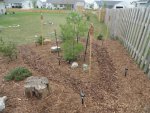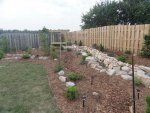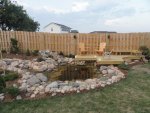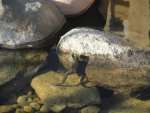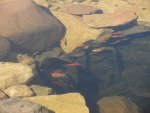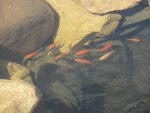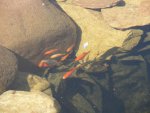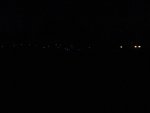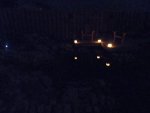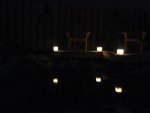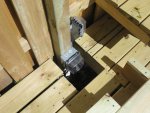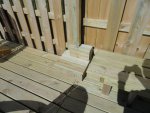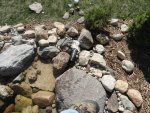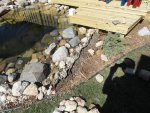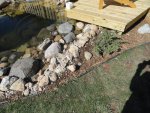Please consider the reason for why overlapping liners can cause leaks. Once it is understood you will never have a problem. It has nothing to due with water pressure. It's
capillary action. It's how trees move water vertically more than 100'. Bricks, cement, sandstone, etc can also "wick" water out of a pond.
In the case of liners it is the closeness of the two pieces that causes the problem. Adding goops only makes the problem worst. It holds the liners a bit further apart but still close enough for a capillary action to occur only with much more volume. And using roof tars and goops not made to fuse with the liner means they just sit on the liner. Water can still get between the goop and the liner.
Sealing two liners together using manufacturer approved products does fix the problem because the bond fuses the two liners into a single piece. Expensive and not easy to get right.
There's an easier choice when the two pieces are above the water line. Do the opposite of instinct and make a larger gap between the liners. That breaks the capillary action and you'll have no problem. And it is very easy to do. It can be as simple as running a bead of silicone horizontally on the bottom liner and waiting a day or so for the caulk to dry or at lease firm up. Now the top liner can be laid over the top over lapping the caulk by at least a couple of inches.
A faster way is to attach a piece of wood horizontally to the bottom liner and over lapping the top liner.
The picture unfortunately doesn't show the top liner overlapping very much. It can. It can run right down into the pond. The
capillary action will occur but stop at the gap and not continue out into the soil. Remember, it isn't the wood or caulk stopping the water, it's the gap. The water never gets to the caulk or wood.
Without a gap some place you can overlap liners for 6 miles and you will still get a
capillary action if one end is in water or wet.
Pretty simple fix once you know the problem.
Plant shelves, I think are the worst idea in ponds. Herons aren't the issue since they have no problem hovering over a pond and grabbing fish. And Great Blues can stand in the middle of many ponds. Raccoons may gain a bit more access, but again, in 3' deep ponds they'll go in shelves or not. However, raccoons will go after the potted plants, knocking them all over looking for food under the pots. It's what they do for a living. And its never a question of if but when. It's no fun at all fixing that mess. And after you do, you get to do it all over again when the raccoons come back. And if you live on planet earth...you have raccoons.
The shelve by themselves are messy. Stuff will come out of pots and into the pond. The soil beneath will often crumble over time and make the shelves uneven and normally sloping into the pond. Cleaning the pond becomes much harder. Koi and pots...yeah, that doesn't work.
And my number one issue with plant shelves...you can see the pots and they look like crap.
I think a better solution is to make a U channel instead of a shelf.
Along the top is a collar made using bond beam concrete block. Because the inside of the block is open the liner can be pushed inside the block and covered with soil. The result is an edge that will never cave in and you'll have about 2" of liner exposed. You can cover with rock or plant right up to the edge and plants will cover it. Or better yet a combination of rock and plants. Many more options.
The second level uses regular concrete block filled with soil. A pressure treated board can be bolted to a few blocks to create a lip. However lots of stuff can be used to create the lip. Right now there are tons of political signs everywhere you can get for free. These are made out of corrugated plastic. Strong stuff and won't rot. Even pressure treated wood will rot someday. You can bunch the corrugated plastic together to make a thicker stronger board. You want the hollow tubes running vertically. To bunch you make a score cut perpendicular to the tubes leaving one face intact. You can now fold it over on itself doubling the thickness. That can be repeated making an accordion type deal. 4 - 6 folds an you have a strong board that will never rot for free. With corrugated plastic you can make it so long that it doesn't have to even be bolted to the block. Instead it can be down in the soil and soil piled against it to hold it to the block.
For pressure treated wood you can drive stakes into the ground and nail 2x4s to the stakes to create a wall. Cheaper than using a 2x12 and you don't have to bolt to the blocks.
The U channel is just a thin blog type filter. But it gives you so many more options. The picture shows the water in the channel being higher than the pond and over flowing into the pond. But the level of the pond can be brought up over the lip and go into the channel.
You can use pots or plant directly into the channel. Just lower the pond level below the front lip and dig around as much as you like without getting the pond water muddy. After planting add water to the channel and let the muddy water settle and you can bring the pond level back up or pump water into the channel and let it over flow into the pond.
The channel also allows you to use tall plants like Cana. Even in pots the channel will keep the pots from tipping over in the wind.
String algae in plants on a regular shelf is a nightmare. With channels you can plant high so the soil is just an inch below the front lip. Plant and then put a layer of water rock over the soil so the top of the rock is above the front lip. Now if you pump water into the channel the water level will be below the rock and string algae hates that. Or instead of pumping water into the channel bring the pond level up. Your liner will be completely covered with the river rock.
I like to use river rock rather than pea gravel because you will have to work in the channel someday to divide plants, etc.
If you ever need to treat your pond with salt or something else you can just drop the water level a few inches to isolate the plant channel and treat the pond without harm to the plants.
I could go on...







